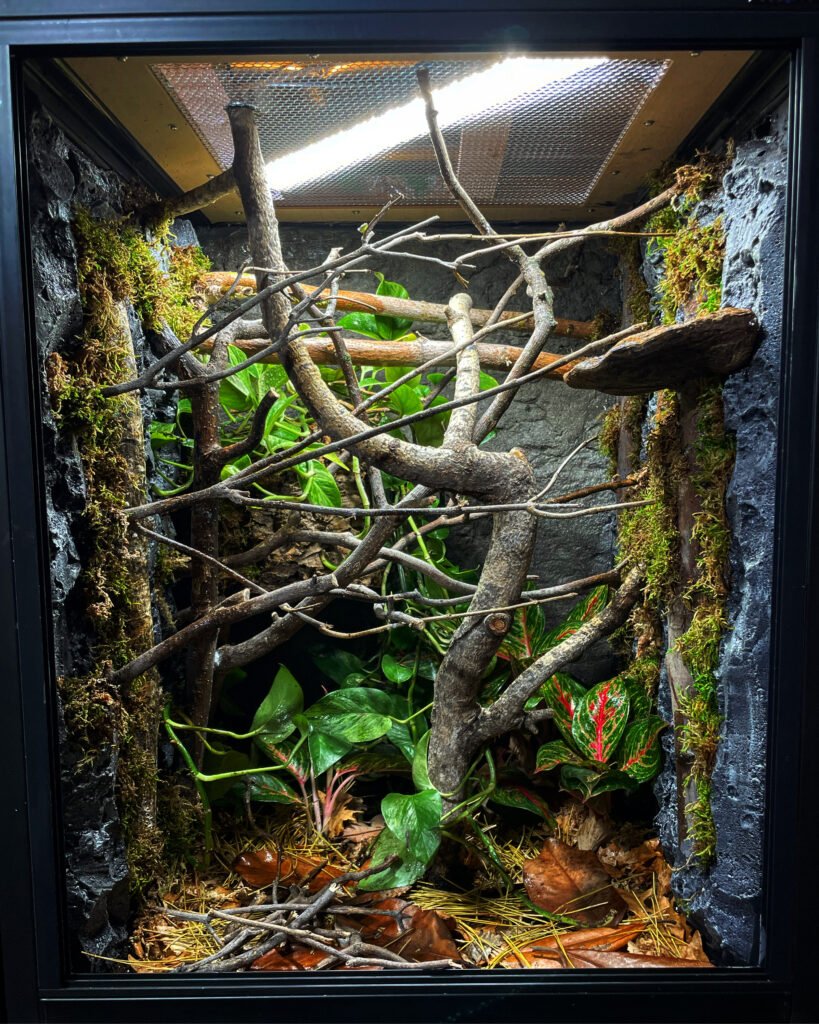Environmental Enrichment: Risk Vs. Reward
Currently, a percentage of the reptile hobby finds itself tilting towards “industrialized” and “sterilized” care. As a result, you might encounter the commonly spouted myth: “The risk of adding enrichment into your reptile’s enclosure is too high, due to the potential of harmful bacteria growth”. In other words, the claim is— you might as well keep your reptiles in an environment that can be sterilized quickly and easily (i.e. paper towel substrate, plastic tub, etc.) to ensure optimal health. Is that true? Is the risk of environmental enrichment truly higher than the reward?
Greater Risk Than Reward—
Certainly, there is a “risk vs. reward” component to providing enrichment to your reptile’s environment. However, enrichment is not always about precisely replicating your animal’s wild environment. Hard-core bio-active folks might argue that point, but the risk of a bio-active enclosure is quite high for beginner hobbyists. An advanced hobbyist will take the necessary time to properly set up a beautiful bio-active enclosure that functions as a proper ecosystem. However, fully bio-active setups can be complicated and should not be where a beginner hobbyist starts. This is one scenario where the risk of harmful mold and bacteria growth is higher than the reward of supplying your reptile with enrichment.
Greater Reward than Risk—
The ability to create a successful bio-active setup is great but there are levels of care simpler than that which can be used to enrich your reptile’s habitat. This would include adding décors such as climbing branches, and natural substrate which can be removed and cleaned. Of course, natural décor (such as wood branches) can not always be completely sterilized or at least not easily sterilized and this tends to act as evidence to support the claim in the first paragraph. However, there does not seem to be any academic evidence to support the claim that a reptile’s environment needs to be 100 % sterile. To be clear, this is NOT a suggestion to keep a dirty environment. This is only meant to point out that reptiles do not need to be kept in a clinically sterile environment (sterile meaning “free from bacteria or other living microorganisms; totally clean”).
Large-scale breeders with thousands of animals under one roof may be able to make a case for complete sterility, but the average hobbyist cannot. In fact, there is plenty of anecdotal evidence from various zoos and wildlife centers that avoid “over-cleaning” their enclosures to promote health. For example, some zoos will even leave old skin sheds and urate pellets inside the enclosure to induce breeding behavior. This works because a reptile will become familiar and comfortable with the sights and smells around them. Fully sterilizing your animal’s enclosure and plopping it back into its newly cleaned home is nearly the same as introducing it into a brand new environment, inevitably inducing a stress response. Therefore, the risk of using décor that cannot be fully sterilized as a form of enrichment is much smaller than the reward.
The Reward: Species-Specific Behavior—
The goal of environmental enrichment is to promote “species-specific behavior.” If your animal is not displaying wild-type behaviors, your setup is lacking in necessary environmental enrichment which can lead to stress. Observing your animal move around their enclosure is a great place to start analyzing their well-being.
Of course, reptiles are commonly quite sedentary but keep in mind, there is a massive difference between an animal that is seldom active and an animal that is never active. Having said that, there is a major caveat with using “movement” as a sign of well-being as not all movement is healthy.
Ideally, you have created an environment that promotes animal activity that correlates with healthy species-specific behavior (digging, climbing, basking, swimming, etc.). Healthy activity will act to replace any abnormal behavior/unhealthy activity such as pacing, aggression, absolute sedentarism, nose rubbing, etc. that may occur in captivity. Your animal will exhibit activity and movement patterns, whether the activity patterns are healthy and positive is totally dependent on how the reptile’s enclosure is set up.
Captive Reptiles Aren’t Wild—
Another classic myth thrown around in the community is that since “we are not dealing with actual wild animals,” there is no obligation to care for them that way.
While it is technically true, at an obvious level, that captive reptiles are not wild, it is important to understand that the animals are not domesticated either. We owe it to the reptiles we own to provide them with an experience that has elements of what they are genetically predisposed to deal with in the wild. We must allow the reptile to act out the behaviors it is biologically designed to act out to ensure the greatest potential of well-being. This should be at the core of the exotic animal-care philosophy. Promoting species-specific behavior through environmental enrichment is more than a mere husbandry recommendation, it is a moral obligation.



